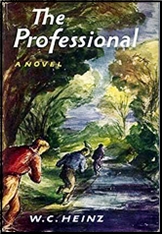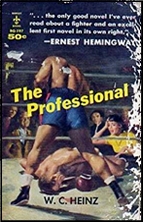Tue 11 Oct 2022
W. C. HEINZ – The Professional. Harper & Brothers, hardcover, 1958. Berkley BG-197, paperback, 1959. Reprinted many times.

A linear, lucid story of a professional boxer as he prepares for a middleweight title match. The prose, spare and clean. The result, wistful.
Eddie Brown has been preparing for this fight his whole career. He’s 29. He treats his body as the well- honed instrument it is. He eats right. Only drinks hot tea. Only eats dry toast and poached eggs. Runs five miles a day.
The narrator is a magazine writer commissioned to profile a boxer training for a title match. He embeds himself in camp for a month, all the way up through the fight.
Eddie’s trainer, Doc Carroll, has been crafting boxers for 43 years. In all this time, he’s only had ten boxers. He takes one at a time, teaches him everything he knows, and brings him up slow. This is his first title fight.
Doc never wanted a title fight before because as soon as you get the title, the trainer loses the boxer. The boxer loses control of their destiny. Special interests control you. You’re a commodity. You can no longer pick your own fights, make your own schedule, be your own man.
But with the advent of televised fights, you can’t make it anymore as a professional boxer going town to town. Nobody goes to the fights anymore. Fans can see them for free from the comfort of their home.

Doc trains his guys to go at the other guy’s strength. To neutralize their punch and go with it. To win on the counter-punch. It takes the will to fight from your opponent when you can take their best and hurt them for trying. You can see it in their eyes, like a stuck bull. But nobody wants to see it. Folks only want to see the windup, the big punch and the knockout.
The fans only get the hype and flair. The media caters to the fans. And the so-called boxers, the so-called champions of the world — they play to the T.V. And the trainers? They don’t give a crap. They don’t know a damn thing about boxing. They just buy boxers in bulk and play it as it lays.
Doc’s the last of his breed. And Eddie’s the best boxer he’s ever had. Eddie’s done everything right. Doted on Doc’s every word. And here’s their big chance. Their last, best and only chance to show the world how boxing is supposed to be. The purity of the sport.
You can guess how it ends.
—-
Ernest Hemingway called it ‘the only good novel I’ve ever read about a fighter.’
The prose is very Hemingway. Which, to me, is a good thing. The story is well told, holds you, and doesn’t let you go. Until the end. And then you’re on your own. Like Eddie Brown, like Doc Carroll. Like the writer of the story that’s no longer of interest to any publisher. Here it is.
October 12th, 2022 at 6:11 am
Damn, your fine review put this right at the top of my “find it & read it next” list.
October 12th, 2022 at 8:49 pm
This one goes on my must find and read list. I might argue with Hemingway about this being the only good novel about a boxer, W. R. Burnett and a few others had decent efforts, but this one sounds like the real thing.
I boxed a bit in college. Like the book says the counterpuncher may not be the most photogenic of boxers, but other fighters don’t like to get in the ring with one so that is well observed.
Interesting contrast between the almost pastoral cover of the hardback and the much more on the nose one for the paperback edition.
October 12th, 2022 at 8:56 pm
According to Wikipedia, “Wilfred Charles Heinz (January 11, 1915 – February 27, 2008) was an American sportswriter, war correspondent, journalist, and author.”
His page there goes on to discuss all of his writing achievements and awards, and there were quite a few:
https://en.wikipedia.org/wiki/W._C._Heinz
This may be of interest:
“In the late 1960s, Heinz collaborated with H. Richard Hornberger to write the novel MASH, published under Hornberger’s pen name Richard Hooker.”
October 12th, 2022 at 9:14 pm
David,
Excellent observation about the lurid paperback cover. Ironic that the cover is meant to sell a book that is philosophically opposed to selling boxing on the basis of sensationalism. I guess the joke was on the reader who bought the paperback looking for a bunch of knockouts.